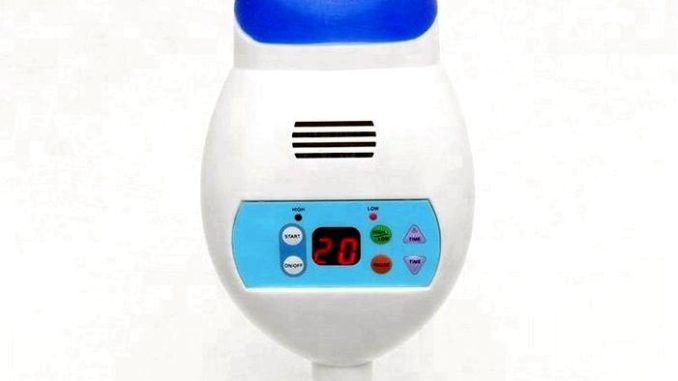
In terms of its effect on a person’s attractiveness, hardly anything else can compare with a beautiful smile. A radiantly white smile is, above all else, white teeth. However, white teeth do not mean healthy teeth. Therefore let’s try to find out how to whiten teeth without damaging them and which whitening system is better?
Throughout history we know that people at all times have been searching for a means to whiten their teeth.
The practice of teeth whitening can be traced back over two thousand years. Doctors of the Slavic peoples in order to get better result, before bleaching they made grinding of enamel surface layer with a metal file, and then used a weak solution of nitric acid. This method was used until the end of the 18th century. Particularly great interest in the aesthetics of the smile and teeth emerged at the beginning of the 19th century. The most effective was the method of teeth whitening, the active element in which was chlorine, derived from a solution of calcium hydrochloride and acetic acid. I think it’s clear to everyone that these whitening methods caused irreparable damage to teeth. But, as they say, «beauty requires sacrifice.». Fortunately, in today’s world, it is possible to achieve tooth beauty without damaging teeth. Already by 1910. all tooth whitening techniques involved the use of hydrogen peroxide, combined with heated instruments or light treatment. And in 1918 the principle of activating whitening was discovered through the use of heat radiation. High intensity light radiation causes a rapid temperature rise in the hydrogen peroxide solution, resulting in a rapid acceleration of the chemical whitening processes. This principle has been improved upon in many ways, and is still the basis of today’s teeth whitening systems. In the twenty-first century, we can safely say that safe teeth whitening exists, but we’ll come back to this later. And if you are interested in professional tooth whitening equipment, visit this link Teeth Whitening.
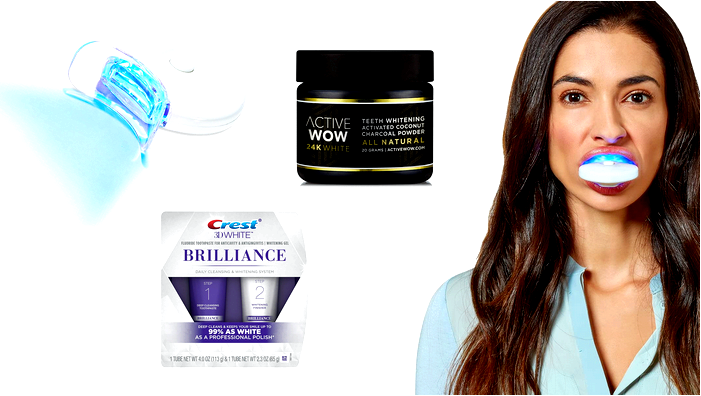
There are these types of teeth whitening:
- -Home (takes place independently at home);
- -office (clinical, is held by a dentist in the clinic)
Generally speaking, there is no difference between the home and office whitening.
Whitening is done by treating the pigment inside the tooth with a bleaching gel, usually containing hydrogen peroxide or carbamide peroxide.
Hydrogen peroxide and carbamide peroxide work as powerful oxidizing agents, breaking down into water, oxygen, and free radicals (atomic oxygen). Hydrogen peroxide releases a significant portion of the reactive oxygen species 30-60 minutes after use. Urea peroxide releases about 50% of the active substances in the first 2 to 4 hours, and the other 50% within the next 2 to 6 hours. The decomposition time is the main difference between the two substances.
The free radicals that are released affect the tooth pigment, which is located in the dentin. It is yellow or gray because of the double carbon bonds. This is the color that the pigment imparts to the teeth.
If oxygen atoms attack the pigment molecules of hydrogen peroxide or urea, the colorless double bonds are replaced by colorless single bonds. As a result, the tooth loses its yellow hue and becomes whiter. This is the mechanism behind all of today’s whitening methods.
Please note: Only your own teeth are whitened. Fillings, veneers, crowns have a completely different structure, and whitening technologies do not work on them.
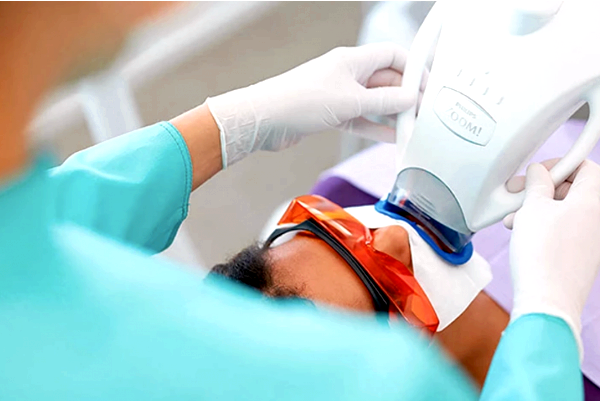
Contraindications to any type of whitening
There is a large number of contraindications to the whitening procedure. For example:
Allergies to hydrogen peroxide or other elements of whitening systems
Dental diseases (caries, gingivitis, periodontitis — these should be removed first);
Abnormal tooth abrasion or deep cracks in the enamel;
Oncological diseases;
certain mental illnesses;
Taking a number of drugs that increase light sensitivity (antibiotics, systemic retinoids, etc.).д.);
Pregnancy and breast-feeding.
Age under 18 due to physiological peculiarities
If you type in a search engine query about tooth whitening, a large number of tools and options will be offered. I strongly advise not to go back earlier and not to use powders, charcoal, soda, acid, and anything else. Take care of your own teeth, and for folk methods there is another use. Among the tools that are produced, only certified, tested and proven in the market should be chosen. A great way to whiten teeth is to visit the dentist! But in order to understand, let’s consider in detail the most current and popular ways of teeth whitening.
Home tooth whitening.
There is an opinion that it is possible to whiten your teeth personally. However, it is important to remember that before using any whitening systems, it is necessary to get a consultation with a professional, because only a doctor can really assess the condition of the teeth and determine whether there are contraindications to the procedure. Uncontrolled use can seriously damage tooth enamel.
In home whitening different whitening strips, pencils and mouth guards with gel are used. But whitening gels, strips and other products that are commercially available contain a small percentage of whitening agents and have negligible and short-lived whitening activity. They are applied to the surface of the teeth, for the suggested time, and if necessary, the procedure is repeated several times to achieve good results.
All such options for home whitening has one main advantage — it is easy and convenient to use, but it should be understood that, in general, the whitening is not more than 2-3 tones. And at the same time they have a rather serious disadvantage — it is their uncontrollability. The least effective among this variety are pencils and strips. Not all systems use universal mouth guards. But they are designed for people with a very straight set of teeth, and there are actually very few of them.Also, if you use a universal mouth guard or whitening strip for crowded teeth and other problems with the positioning of the teeth, there is an increased likelihood that the peroxide will penetrate the gum and cause a burn. Therefore, when choosing a system for home teeth whitening, it is better to give preference to professional, i.e.е. Those that use individual mouth guards.
Custom-made mouth guards are made to order based on an impression of the jaw and are suitable for multiple applications. They precisely follow the shape of the tooth row, making good contact between the whitening gel and the tooth surface. Because of this, there is less chance of the gel penetrating into the mucosa of the gums and mouth, reducing the risk of burning the gums. It and the low-concentration whitening gel can be applied independently by the patient. The duration of the mouth-guard depends on the concentration of the whitening agent, as well as the good result.
The product is chosen by the doctor, based on the unique situation of the patient — the natural sensitivity of the teeth, the presence of gum disease, hard tissue quality, etc.д.
The effect as a result of home whitening lasts for a long time. All depends on the stability of the color dental dentist may recommend a short maintenance course once every six months.
The traps can be worn both during the day and at night. The first signs of discoloration appear on the fourth or fifth day and increase in intensity by the end of the course. The complete Philips Zoom home whitening systems, DayWhite and NiteWhite, and Opalescence PF gels are based on the use of custom-made trays.
Negative effects of home whitening systems can be said if the patient violates the recommendations and indications. For example, putting too much gel in a mouthguard causes it to be squeezed out when placing it on the teeth: the gel gets on the gums and burns the mucosa as a result. Or the patient, in order to increase the effect of whitening, wears a mouth-guard for a longer period of time than prescribed.
It is always necessary to follow the recommendations precisely. It must not be forgotten that patients with very sensitive teeth will experience a sudden increase in sensitivity when whitening. Home bleaching as the main treatment only makes sense if the patient’s teeth are light to begin with. In the case of yellow teeth, the result will be very little, virtually zero.
Peculiarities of home whitening:
Home whitening «asks» a lot of time — from 2 weeks to a couple of months of constant application;
The concentration of gel in the case of home bleaching is 2-3 times less than in office procedures;
Home whitening involves self-application of gel, wearing a mouth-guard, and further removal of the remaining active ingredient, all on a permanent basis.
I recommend home whitening in both variants:
As a consolidation in a comprehensive professional whitening;
as a maintenance after 4 to 6 months from office whitening.
In order for the procedure of whitening to go without any damage to your health, I strongly recommend leaning towards the professional methods of whitening, which are supervised by a dentist.
What is the best way to whiten your teeth??
According to dentists, a whitening system is judged on the following parameters: safety, effectiveness, and speed. In order to understand what is the best whitening, let’s compare the pros and cons of different office whitening methods. If the main criterion for evaluation is effectiveness, then the office whitening (any of them) is superior to home whitening.
Professional (Clinical) Teeth Whitening
All clinical dental whitening procedures follow the same principle: whitening is achieved by applying a gel to the surface of the teeth, the main element of which is hydrogen peroxide.
Professional office whitening comes in four types:
Chemical whitening (the doctor applies a gel to the teeth);
Thermal photobleaching (the gel is applied and activated by a lamp with a warm light that heats it);
Cold light photo whitening (the gel is activated by a cold diode light, and there is no heating);
Laser (the gel is activated by a laser beam).
Note: activation is the process of accelerating the chemical reaction of the gel due to the influence of external environment: light, temperature, other reagents.
Chemical method of bleaching.
In chemical bleaching, the activation of the gel is done by mixing it with a chemical catalyst, and no external catalyst is needed,
It is the easiest and cheapest procedure to achieve a lighter color of teeth than nature intended.
The Opalescence Boost (Xtra) whitening system is considered the most popular. It is a highly concentrated gel with 35% hydrogen peroxide. The working principle is simple: the activated gel is applied to the teeth, rinsed off after a certain period of time and the procedure is repeated. Teeth are whitened by 5-10 shades in 1 session. The whitening is practically harmless, because as such there is no risk of overheating the pulp. So what’s the downside?? The disadvantage is that to achieve an excellent result, you have to use a large concentration of gel and perform a longer exposure, which contributes to the drying of teeth and increased period of sensitivity after the procedure. However, there are also advantages — it is the absence of overheating of the teeth, affordability and price. That is why the Opalescense teeth whitening system still holds its own.
Photo whitening (warm light activation)
WhiteSpeed Professional Philips Zoom is a globally popular technology and professional teeth whitening system. This whitening system was invented in America. The essence of the method is as follows: it uses a special whitening gel, which is activated under the influence of ultraviolet light. At first, this method had big disadvantages. But the system gradually improved and became safer.
Zoom3 has already boldly conquered the world, achieving the title of safe and successful.
With this whitening method, a UV-lamp is used to activate the bleaching gel for better peroxide penetration into the dentin, resulting in a more effective whitening effect.
Ultraviolet light acts on the bleaching gel, which contains up to 35% hydrogen peroxide, and activates the oxidizing agents in it, while the surface of the tooth can be heated, respectively, after the procedure, the sensitivity of teeth can significantly increase. The advantages of this option whitening: teeth whitened to 8-10 shades, the result will be obtained in one session, the procedure is virtually harmless. The disadvantages are the same as in the case of chemical whitening: the period of tooth sensitivity increases and increases, only in the case of zoom3 because of overheating of the teeth. This system already assumes a gel to relieve this unpleasant symptom. The benefits in terms of affordability and price are saving the ZOOM3 position. This way of whitening is successfully done by dentists and is popular among patients.
However, giving an answer to the question «a great whitening system according to the professionals» — I very rarely discuss these types of whitening with my own patients, due to the emergence of more modern techniques. If for some reason the innovations are not available, then do not worry, the techniques discussed will still be better than continuous uncontrolled home whitening. If the work is done by an experienced doctor, the result will be 100% and without bad consequences and discomfort.
Advanced Technology — the highest efficiency
Photobleaching (cold light activation)
LED, or cold light is a modern way to activate the whitening gel. LED lights do not heat the surface of the tooth and do not dry it out. This minimizes the risk of sensitivity and significantly improves tolerance of the procedure.
The actual LED light source is equipped with a whitening lamp system Philipszoom4 generation. Because it emits LED light, the system is called cold whitening.ZOOM 4 is the latest generation of photo teeth whitening with the utmost gentleness to the teeth and greater effectiveness!
Therefore the gel contains a low concentration of hydrogen peroxide (about 25%), which starts the activity after exposure to light, with very high efficiency, so the effect time on the teeth is much less than previous systems. The second element is alkaline, whose function is to stop the acid from forming and eliminate the destruction of enamel. The last step: treatment of teeth with Remineralizing Gel Relief, containing amorphous calcium phosphate, which enriches the enamel with calcium, fills the dentinal tubules and saturates the hard tissues of the teeth with minerals. This gel provides enamel restoration and reduces overall tooth sensitivity.
The entire procedure is painless and psychologically comfortable. The results of Zoom whitening are long-lasting and depend on the observance of the recommendations. The disadvantages are usually only the price of the procedure.
Pros:
It allows you to change the color of enamel up to 8 to 12 colors in a single session
ZOOM 4 is equipped with a cold LED light source, eliminating overheating of the deep layers of the tooth and gums;
Suitable for patients with tooth sensitivity;
ZOOM 4 technology does not thin or damage the enamel;
great reduction of exposure time on the teeth and thus the entire procedure
The result lasts up to 3 years;
Laser whitening Dr. Smile
Laser teeth whitening is a method of professional teeth whitening based on the use of laser in combination with a special gel.
The gel contains 30% hydrogen peroxide and a catalyst for the laser beam. The gel collects the laser light and breaks down into particles that whiten the enamel of the teeth.
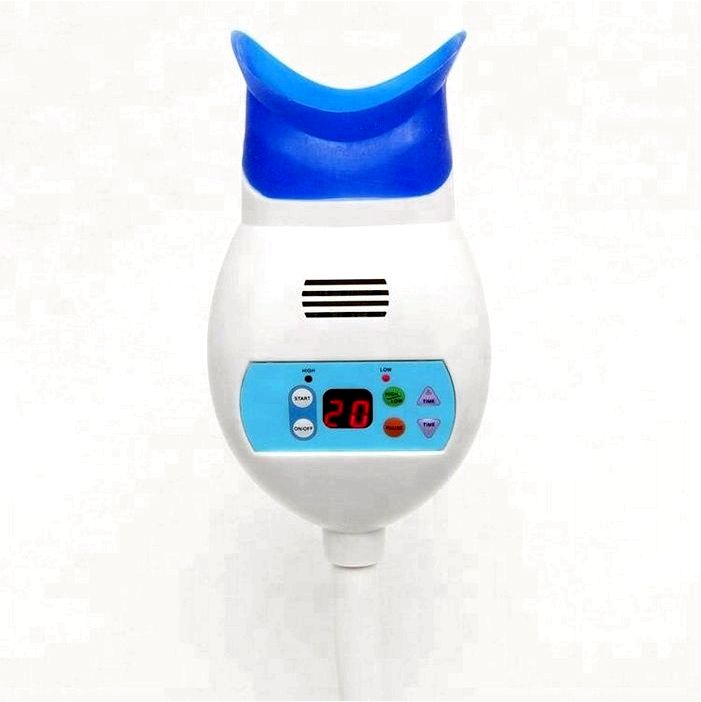
Just one to two minutes of laser exposure to a tooth coated with a whitening gel is enough to produce a positive effect, even in very difficult cases. There is an opinion that the effect of laser whitening is more expressed through the ability of the laser to break down the pigments. Another undeniable advantage of the method — it is a more controlled bleaching process, which reduces the risk of pulp overheating and other acceptable difficulties. The Dr. Smile is a computerized system with integrated software for all procedures. The computer has programs for all procedures with clinical information and parameters. Therefore, this teeth whitening is safe and meets the requirements of the protocol. In the final stage, the teeth are coated with gel (to reduce sensitivity), which is also activated by the laser.
To date, we can honestly say that the laser teeth whitening is a method that does not damage the enamel of teeth and provides long-term stable results.
Among the disadvantages of laser whitening one can only mention its high cost.
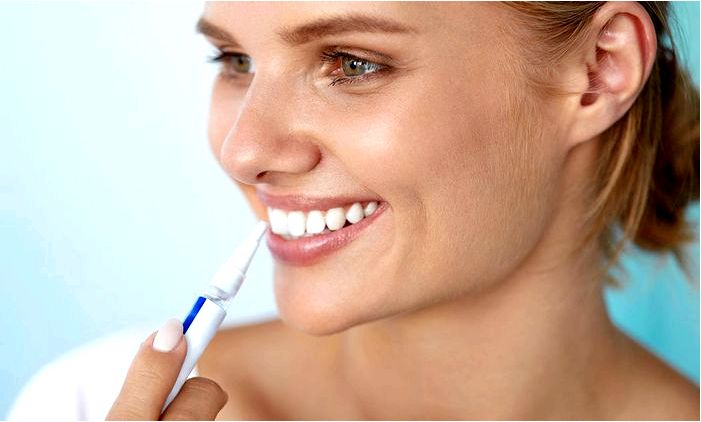
The advantages of laser whitening:
laser whitening procedure is indicated for people with high sensitivity, as there is no heating of the tooth tissue.
All kinds of pigmented formations are removed;
It is possible to whiten teeth by 8-12 shades in one session.
Dental enamel is not damaged by laser radiation
Laser radiation has bactericidal qualities
It is possible to control the process thoroughly by choosing the intensity and duration of the treatment;
reducing the time of action on the teeth and thus the procedure in general;
the result is long-lasting — up to 3 years
Notwithstanding the fact that the parameters of exposure can be chosen very precisely, the result is considered to be individual. If a good result is not obtained after the first session, another treatment is possible. The perfect result lasts for years. But this is still quite personal. The effect can last as long as possible, however, if certain rules are not violated:
It is necessary to give up eating foods with coloring substances (or at least reduce their consumption);
It is recommended to give up smoking altogether;
For daily oral hygiene, it is necessary to use professional toothpastes with a light whitening effect;
you have to use very good quality toothbrushes or even replace them with an irrigator;
Twice a year, it is recommended to have your teeth professionally cleaned.
Your teeth will always be whiter than before laser whitening because there is no going back to the original shade.
Effective whitening system:
When selecting a method of teeth whitening, first of all, the doctor relies on medical conditions and contraindications for the procedure, as well as the individual characteristics and wishes of the patient.
All professional methods allow to achieve considerable and stable results.Our dental clinic uses modern equipment and the best preparations for tooth whitening.
To remove the question about the choice of whitening method, you need to make an appointment for a consultation with the doctor. After a thorough examination of your teeth and mouth, your doctor will recommend a more appropriate tooth whitening plan and agree on the cost of treatment.
Professional Teeth Whitening — A Safe, Effective Procedure.
Modern whitening systems effectively cope with the problem of yellowing of the teeth, making it possible to achieve a significant and long-lasting whitening effect.
Laser whitening and photo whitening with cold light are considered to be the most effective. In configuration with a supporting course of home whitening with the use of individual drops they give excellent results.
The effectiveness and quality of modern whitening systems are time-tested and considered safe with proper use and consultation with the doctor.
Отправить ответ